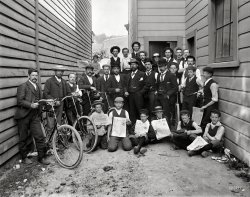
MAY CONTAIN NUTS

Search Shorpy
SHORPY ART

Framed or unframed, desk size to sofa size, printed by us in Arizona and Alabama since 2007. Explore now.
Join and Share
Ad-Free Shorpy
Shorpy is funded by you. Patreon contributors get an ad-free experience.
Learn more.

Recent comments
- S&P
- 1940 Zenith radio model 6G601
- Quality goes in before the name goes on!
- Snazzy skirt
- Carbon Arc Lamps
- Illuminate us
- I remember it well
- I can't prove it
- Complicated then, forgotten now
- Bryan-Stevenson
- Skinny is as skinny does
- How do you rest in peace
- Riding the footboards
- Alas, hidden from view
- Baldwin Diesels
- Exclusive pump
- Bananas, Oysters and Smokey Joe
- Details, Details
- What's that building to the left of the tower?
- Coal Barges
- Bromo-Seltzer
- Inner harbor
- The Basin
- What a headache!
- Giant stepladder?
- Yeah, it was cold
- Love those coats
- Link & Pin Days Remnant
- Baldwin 62303
- Baldwin VO-1000
Member Photos
The Shorpy
Print Emporium
Print Emporium
Search Shorpy
Search results -- 30 results per page
- Harry's Villa: 1901
- ... love the tree "house."
The good old days I love the bicycles, especially the one leaning under the platform surrounding the ... This image is just plain fantastic. From the vintage bicycles to the fantastic clothing modeled by some easy going town folk. An ... Posted by Dave - 08/13/2013 - 3:45pm -
![Harry's Villa: 1901 Mississippi circa 1901. "Harry's Villa, Bay St. Louis." 8x10 inch dry plate glass negative, Detroit Publishing Company. View full size.
Simply grandI love this photo. How wonderful. I have never seen a picture of such a well dressed crowd looking so casual. If you could step back in time and just land here, it wouldn't be so bad to hang around for a day.
"Buster Brown"I expect Buster's name was either Beauregard or Leroy!
TextureSuch an interesting shot. I love all the texture from the tree, roof, and dirt. The people are interesting too. Like the little boy on the railing and the zonked out guy in the hammock.
Carbide lampThe bike "horn" that one person noted is a headlight powered by carbide pellets and water mixed to create a gas and then lit (like early mining lamps). Very cool photo that is now my desktop wallpaper. Love it!
A beautiful and lost timeMost of Bay St. Louis appears to have been swept away by Katrina. Almost all of the beachfront lots are still empty, with nothing but slabs, or front steps leading to houses that no longer exist.
Shady Rest"There's Uncle Joe, he's a movin' kinda slow, on the hammock."
I Wonderhow many more years went by before that tree crushed Harry's Villa?
Arboreal TemptationI'm sure any of Harry's younger guests would have been tempted immediately by that tree. Good ole Harry even provided a platform to make it up to the first level. I wonder how many took on the challenge before the yelling and running around got started.
Hanging outEveryone looks so front-and-center for their photo op, except for the fellow in the hammock, who couldn't be bothered.
I'm just wild about Harryand his villa, but can't find any info on it. Another copy of this picture is located on the Hancock County MSGenWeb site, but sans remarks. It is quite a nice little 19c Greek cottage, and I love the tree "house."
The good old daysI love the bicycles, especially the one leaning under the platform surrounding the beautiful tree. Check out the horn!
[As noted above, that's a headlamp. - Dave]
Takes my breath away.This image is just plain fantastic. From the vintage bicycles to the fantastic clothing modeled by some easy going town folk. An instant in time captured that seems like so long ago, but looks like it was taken only yesterday.
That tree stand must be for watching the Fourth of July parade.
BTW, is that Buster Brown standing on the railing???
Amazing photo!The house looks like a facsimile of the Jefferson Davis House - Beauvoir - over in Biloxi about 30 miles away. The seating area around the tree is called a "Shoo-Fly" - it was built up off the ground so that in the evening people could sit (and smooch?) above the ground and avoid the low flying mosquitoes, gnats, and flies that are fairly pervasive during the warm summer months.
Wonderful placeBay St. Louis, Biloxi, Gulport, Waveland - all along the Mississippi Gulf Coast a lot of these houses were owned by families from New Orleans who stayed there in the summer to escape the worst of the heat and humidity in the city - at least you had the breezes off the Gulf. My father's parents had a house in Gulfport on the beach, and Dad talked about how my grandmother, his sisters and he would go stay there in the summer. My grandfather would stay in New Orleans, and come out to Gulfport on the weekends, taking the train that used to run regularly from N.O. along the towns on the Gulf. This was back in the 1940's. People had been vacationing there since the 19th century.
When I was a kid in the 1970's my parents and I would sometimes stay on the weekends at a house in Bay St. Louis which was owned by cousins of very good family friends of ours, when it was loaned to them. The house had originally been built in the 1880's. It was a big Queen Anne house, originally a third of an even more enourmous house. During some earlier hurricane, the center of the house was heavily damaged, so the center was torn down, and two houses made out of the left and right portions. Considering the remaining houses were not THAT close to each other, and were both sizeable themselves, the original must have been truly gigantic. I remember 12'-14' ceilings, floor to ceiling windows, wallpaper that must have been from the 30's, no AC, huge screened porches with swings, thinking back on it now.
The house was sold 30 years ago, and completely renovated by the new owners-I passed by it about 10 years ago. It was destroyed in Katrina, as were all the places around it.
WealthAnother thing that I haven't seen commented on (yet) is that this family is probably very well off financially. The title itself loosely implies this is a home away from home. Also everyone has shoes on (odd for this time period for younger children). And that kid on the railing is quite plump. All these little things add up to... Harry's done well for himself.
It's just an observation... nothing else should be taken from it.
[This is most likely a boardinghouse for vacationers. - Dave]
Note the Spanish MossNote the Spanish Moss hanging on the tree in the upper left of this photo; this is a good representative example for those of y'all not familiar with it.
Well before Katrina, Camille devastated this area in 1969. Until then, US Highway 90 between Pascagoula and Bay St Louis was one of the prettiest scenic drives in US, with old large houses, many antebellum, white fences, and large oaks with spanish moss on one side, and white sandy beaches on the other side.
---
Just a hop, skip, and jump along the coast east of Bay St Louis:
https://www.shorpy.com/node/6834
https://www.shorpy.com/node/6834
https://www.shorpy.com/node/6230
https://www.shorpy.com/node/5717
https://www.shorpy.com/node/4617
https://www.shorpy.com/node/3699
https://www.shorpy.com/node/3698
https://www.shorpy.com/node/733
No PeekingIs that a modesty panel inside the railing around the Shoo-Fly? I should imagine that a glimpse of an ankle or (heaven forbid) a leg would be quite unseemly during this time period. Wouldn't want anyone at sidewalk level to see anything they shouldn't.
(The Gallery, Bicycles, DPC, Travel & Vacation)](https://www.shorpy.com/files/images/4a08953a.thumbnail.jpg)
- Garter Girls: 1925
- ...
Femme Pédale Both of the ladies are riding "boy's" bicycles. I guess they just grabbed whatever was available for the shot. The ... 6! The old names are making a comeback.
(The Gallery, Bicycles, D.C., Natl Photo, Pretty Girls) ... Posted by Dave - 08/13/2013 - 4:31pm -
![Garter Girls: 1925 February 7, 1925. Washington, D.C. "Mildred Billert and Hazel Bowman of Ned Wayburn's Revue." National Photo Company glass negative. View full size.
Dangerous poseEven with the kickstand down, I can't believe that was all too stable a position, but it does give the illusion that she's peddling.
[And pedaling. -Dave]
Also not seen much anymoreGirls named Mildred and Hazel are almost as rare as swastika tire treads.
AchtungThe swastika tread design isn't seen much anymore.
Femme PédaleBoth of the ladies are riding "boy's" bicycles. I guess they just grabbed whatever was available for the shot. The "step through" frame girl's bikes, once de rigueur for proper young ladies, especially before it became acceptable for women to wear trousers.
Nice catch rhhardinThe bicycle is a British 1925 Ariel.
Tabloid Musical Comedians
Washington Post, February 1, 1925.
The biggest tabloid musical comedy ever attempted in vaudeville will top the bill at B.F. Keith's theater with the current week, beginning with the matinee today at 3:15 p.m. Ned Wayburn's "Honeymoon Cruise" is the title of this junior musical comedy presented in six big scenes with a score or more of Ned Wayburn pupils and proteges. The book and lyrics were written by Arthur Swanstrom, and the music by Carey Morgan. The membership of the company, all graduates of Ned Wayburn's famous school of dancing, includes James Clemons, Hazel Bowman, Arthur Swanstrom, Mildred Billert, Helen Dobbin, …
Actually,I know a Mildred who is about 30 and a Hazel who is roughly 6! The old names are making a comeback.
(The Gallery, Bicycles, D.C., Natl Photo, Pretty Girls)](https://www.shorpy.com/files/images/SHORPY_12973u.thumbnail.jpg)
- Toledo: 1899
- ... a million If you look closely, you will see quite a few bicycles in this scene, including the one on the corner with a lady rider. A ... modern bike had been invented. By 1899, about a million bicycles a year were being manufactured with a value at more than $31 million. ... Posted by Dave - 08/13/2013 - 3:42pm -
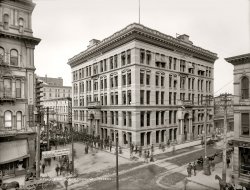
- Tower of the Press: 1905
- ... Time was Beautiful ornate buildings and no locks on the bicycles. What happened, America?
[Someone eventually invented the bike ... Some good news about this building.
(The Gallery, Bicycles, DPC) ... Posted by Dave - 05/24/2016 - 12:10pm -
![Tower of the Press: 1905 Binghamton, New York, circa 1905. "Kilmer Building, Chenango Street." Also known as the Press Building, this was headquarters of patent-medicine magnate Willis Kilmer's newspaper. 8x10 inch glass negative. View full size.
I Don't Blame HerI wouldn't want to be pulled into the surf either when wearing a wristwatch and in shoes with high heels (Cuban heels?)
[Which window is that? - Dave]
RemodelingLooking through the lobby windows and the debris outside it appears to look like the lobby is being remodeled.
[Actually they're building the building. - Dave]
Parking problems.Hopefully they'll install the bike racks soon.
Time wasBeautiful ornate buildings and no locks on the bicycles. What happened, America?
[Someone eventually invented the bike lock. - Dave]
ConnectionsI am looking at the connection to the other building on the right and wondering if that is part of the construction or is the tall one an add-on?
But will there be bike racks?Some good news about this building.
(The Gallery, Bicycles, DPC)](https://www.shorpy.com/files/images/SHORPY-4a12441a.thumbnail.jpg)
- Wagons Ho: 1901
- ... white color of natural rubber. - Dave]
(The Gallery, Bicycles, D.C., D.C. Street Survey, Horses, Kids, Railroads) ... Posted by Dave - 04/26/2022 - 3:46pm -
![Wagons Ho: 1901 Washington, D.C., circa 1901. "View of S.W. Block 386, probably D Street side of Baltimore & Potomac Railroad freight station at Maryland & D, 9th & 10th Streets, showing man loading freight into delivery wagon." 5x7 glass negative, D.C. Street Survey Collection. View full size.
What's in the wrappers?Are those Gatling Guns wrapped up? Sure looks like it!
(See the unwrapped version here: https://www.spanamwar.com/Gatling)
That’s some freight stationYour one-stop-shop for machine guns and whiskey!
A plug for ShorpyI was curious about Wilson Whiskey and found this ---
https://emmettwilsonbook.com/2015/08/27/his-brand/
Back to the FutureThe bike on the porch looks out of place in a 1901 setting. It would fit into any current-day setting, white sidewalls and all.
[The entire tire is white, not just the sidewall. Before manufacturers began adding carbon black around 1910, tires were the white color of natural rubber. - Dave]
(The Gallery, Bicycles, D.C., D.C. Street Survey, Horses, Kids, Railroads)](https://www.shorpy.com/files/images/SHORPY-40365a1.thumbnail.jpg)
- The Auto Zone: 1921
- ... - Dave]
Those were the days Free air, and also bicycles for the taking. Only one of those things remains today.
Non-Skid ... https://www.shorpy.com/node/4480
(The Gallery, Bicycles, Cars, Trucks, Buses, D.C., Natl Photo, Stores & Markets) ... Posted by Dave - 08/13/2013 - 4:10pm -
![The Auto Zone: 1921 Washington, D.C., circa 1921. "Lee Tire Sales Co., exterior." A clutch of transport-related businesses on 14th Street N.W. National Photo Company. View full size.
1600 14th Street NW todayThe store (1600) was at the corner of 14th and Q.
View Larger Map
I See Dead PeopleI think I saw that little girl and her twin sister in a recent horror film about a haunted house. Whenever they appeared there was childrens laughter in the backround and the bone-chilling nursery rhyme music associated with poltergeists. Now I'm scared.
Signs?I've noticed with all these DC photographs, there are no street signs, which surprises me for such a populous area. Was that normal?
[Look again. Here, here and here, to give three recent examples. - Dave]
Those were the daysFree air, and also bicycles for the taking. Only one of those things remains today.
Non-Skid RowThis typical row of storefronts was previously featured in the background of a 1932 accident scene: https://www.shorpy.com/node/4480
(The Gallery, Bicycles, Cars, Trucks, Buses, D.C., Natl Photo, Stores & Markets)](https://www.shorpy.com/files/images/30157u.thumbnail.jpg)
- Welcome to Detroit: 1900
- ...
I love the two men languidly conversing on their bicycles, oblivious of the surrounding traffic. Try that today! In toto the ... . City hall is long gone. - Dave]
(The Gallery, Bicycles, Detroit Photos, DPC, Streetcars) ... Posted by Dave - 08/13/2013 - 3:50pm -
![Welcome to Detroit: 1900 Detroit, Michigan, circa 1900. "City Hall and Campus Martius." To the left, the Soldiers and Sailors Monument; rising to the right is one of the city's "moonlight tower" carbon-arc lamps. Palm trees and bananas strike a tropical note. 8x10 inch glass negative by Lycurgus S. Glover, Detroit Publishing Co. View full size.
American IdyllI think any city would be glad to have such a civic building. Interesting French (Second Empire?) style architecture.
I love the two men languidly conversing on their bicycles, oblivious of the surrounding traffic. Try that today! In toto the pedestrians look like a idealized Hollywood scene representing city life at the turn of the 20th century; people running, promenading, talking, pricing fruit perhaps on a fine summer's Sunday.
Moonlight Towers: now Austin residentsThose carbon-arc lamps were once very common ways to light a city, much more economical than a lower-wattage streetlight every 100 feet. The light they gave off was by all accounts glaring and harsh, though.
In 1894 Austin TX bought a bunch of the towers from Detroit and moved them southwards. Through a fluke of history, half of them survive to the present day, making them the only remaining functional towers in the world. One played an important cameo in "Dazed and Confused." All the remaining towers (17 of the original 31) are protected historic monuments, though two were recently removed. Austinites, myself included, are strangely fond of them.
The rest of the story: http://en.wikipedia.org/wiki/Moonlight_tower
Idyll Over"I think any city would be glad to have such a civic building. Interesting French (Second Empire?) style architecture."
You might think that, but Detroit tore this building down in 1961. It was seen locally as embarrassingly old-fashioned soon after the turn of the 20th century.
The editor of the Detroit News described it thus: "It is an architectural monstrosity. It belongs back in the twilight zone of American development. … It belongs to the era of the whatnot and the putty vase and the ship carved in a bottle. It is not Colonial, it is not Gothic, it is not Byzantine. It just ain’t nuthin’. It’s been standing there these 70 years or more, a lumpy, gloomy, ugly pile of curlicued stone. No artist has ever painted a picture of it. No artist would. No lover of beauty has ever found a single line of grace or dignity in it."
And not a car in sight. I think this photograph shows the destruction wrought on the American landscape, and social fabric, especially in urban settings, by the advent of the automobile a short time later.
The Motor City!Where are the cars?
(Always interesting to me how long it took for automobiles to take hold.)
Moonlight Bat BuffetLiving in Austin in the 80's I used to frequent a cafe in the Clarksville section of town where I would often see some of Austin's famous Mexican free-tailed bats feasting on the insects drawn to glow of moonlight towers. Austin, whose unofficial motto is "Keep Austin Weird," is a Mecca for bats, batty moonlight tower protectors, and all things odd and different. I'm glad to hear from Kevin M. that the towers are still there.
All those people are deadbut yet, when I put this on full screen, I still get the feeling I could just step into the scene and walk or ride my bike amongst them. I love these pedestrian/scenic pictures. Sure glad somebody invented the camera when they did.
CinematicThis does look like a Hollywood scene! Now we have our cars, our phones, our iPods, etc., and you would never see people out strolling about and chatting like this! We (myself included) are always in our cars and in a hurry!
Wayne County BuildingOne of the previous commentators mentioned that this building was torn down. It is actually still standing.
[You're confusing City Hall with the Wayne County Building. City hall is long gone. - Dave]
(The Gallery, Bicycles, Detroit Photos, DPC, Streetcars)](https://www.shorpy.com/files/images/4a18953a.thumbnail.jpg)
- Tour de Fence: 1900
- ... this 4x5 inch glass negative with the caption "L.K. -- bicycles at spring." View full size.
I Saw Her Too No strong drink ... but funny hats are mandatory!
(The Gallery, Bicycles, Found Photos) ... Posted by Dave - 11/25/2014 - 11:51am -
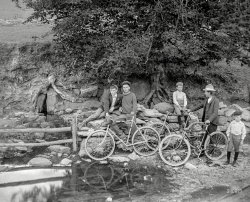
- Inflationary Pressure: 1936
- ... Used to see the same thing on freight-carrying bicycles in Korea many years ago.
Horsefeathers I had a bike like this ... really been painful on his tootsies.
(The Gallery, Bicycles, Kids, Russell Lee, Small Towns) ... Posted by Dave - 08/13/2013 - 3:39pm -
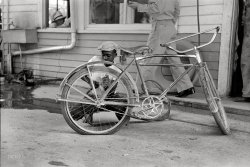
- The Colonial: 1901
- ... attention, I wonder. He's just to the right of the "Bicycles" sign.
Does anyone know the name of the wheeled chair behind ... and the murder has never been solved.
(The Gallery, Bicycles, DPC) ... Posted by Dave - 09/07/2021 - 9:11am -
![The Colonial: 1901 Circa 1901. "In the gardens -- Colonial Hotel, Nassau, Bahamas." Built by Henry M. Flagler on the site of Fort Nassau, the hotel was destroyed by fire in 1922. Its current incarnation is the British Colonial Hilton Nassau, owned by the China State Construction Engineering Corporation. 5x7 inch glass negative, Detroit Photographic Company. View full size.
The Burn File It's been far too long since our last entry in the Hotels Which Burned To the Ground series. Beauties, every one of them, and this is certainly a worthy addition.
What has captured the gardener's attention, I wonder. He's just to the right of the "Bicycles" sign.
Does anyone know the name of the wheeled chair behind the three men, just in front of the stairs? It looks as if it might be the kind which could be guided by its occupant, using a center control bar.
[Not quite. - Dave]
Rabbit hole alertOne of the owners of the follow-on hotel, the British Colonial Hilton Nassau, was Harry Oakes. If you have an hour or four, search out his story. He was a gold miner turned tycoon that owned a big chunk of the Bahamas. He was also murdered in Nassau in 1943, and the murder has never been solved.
(The Gallery, Bicycles, DPC)](https://www.shorpy.com/files/images/SHORPY-4a27469a.thumbnail.jpg)
- Bottle Club: 1909
- ... my day... it was called a "Glass Hat"
(The Gallery, Bicycles, Kids, Lewis Hine) ... Posted by Dave - 08/13/2013 - 3:59pm -
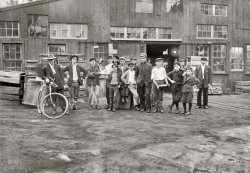
- Detphoco: 1903
- ... what are those "Special Toilet Uses"?
(The Gallery, Bicycles, DPC, NYC, Stores & Markets) ... Posted by Dave - 08/13/2013 - 4:33pm -
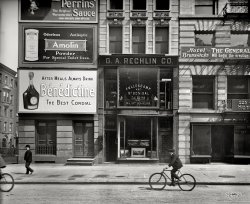
- Look, Ma: 1921
- ... stand!
Sprockets Yes, most modern, and ancient, bicycles have a front sprocket that is several times the size of the rear ... more like a baguette, I have no idea.
(The Gallery, Bicycles, D.C., Herb & Joe, Natl Photo, Sports) ... Posted by Dave - 08/13/2013 - 4:06pm -
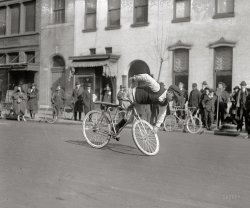
- Congress Street: 1910
- ... can see that it is a LONG walk, indeed!
(The Gallery, Bicycles, DPC, Streetcars) ... Posted by Dave - 08/13/2013 - 3:34pm -
![Congress Street: 1910 Portsmouth, New Hampshire, circa 1910. "Congress Street." 8x10 inch dry plate glass negative, Detroit Publishing Company. View full size.
You're all looking in the wrong windowSo many people have commented on the sinister looking man in the window on the left. For goodness sakes, take a good look at the window on the far RIGHT! Not only does there appear to be a jack-o-lantern like skull near the very top of it, but if you look even more carefully, it appears to be sitting on the shoulders of some alien like beast with an enormous head!
Psychedelic signageWas there such a thing as an oculist pole? Also, there are many wagons here but few horses. Where are they?
[Attached to the wagons. Four wagons and four horses below. - Dave]
Unchained bicycleAn unusual sight these days is seeing a bicycle that is not chained to a post, etc.
Top Left (Out of Picture)What could those guys on the mid-left be looking at?
A current viewView Larger Map
(I hope I did this right.)
re: Top LeftThose two guys are probably saying "#!@&*# vines!" On the other hand, Mr. High Pockets seems entranced by the lamp.
Hey you!I wonder if the man in the window was speaking to the photographer, attracting the man on the sidewalk's notice.
How does a lady cross the road?Whilst crossing the trolley tracks, the lady raises her skirt, ever so slightly, to keep it out of the excrement and other debris that lie there.
SnidelyNote the sinister looking gent in the window of the building on the left.
Concerning "Mr. High Pockets"I rather think the photographer, just before he squeezed the bulb
and out of habit, yelled:"watch the birdie."
Mr. High PocketsI think he's looking up towards the open window. May be a loud conversation going on.
In the windowThere is a sinister looking fellow in the window of the building on the left.
Creepy Guy Alert!Second story window of the Mens Association building.
Not really that creepy but I like that as the title.
This view is a little better I thinkThis view is a little more accurate I think. The buildings on the right are hard to see through all the foliage in the original photo, but the building on the left seems to be mostly intact. Except they removed the bay windows. Why?!
View Larger Map
Guy in the window of the YMCA to the left.I looked, but I don't think that building exists anymore. I wonder if that is an office or something.
Exciting ContestOne streetcar driver to the other: "Wanna race?"
Who's in the window? What's he doing?The man by the bicycle is looking at someone in the window.
Another cell phone time travelerAfter the cell-phone time traveler found in the clip from Charlie Chaplin's The Circus was discovered, I didn't think another one was possible. And yet, there is a young girl with that familiar hand held to the ear that is all the rage (on the sidewalk, in the sunlight).
Today's viewLooks like Sake Japanese Restaurant is now in the YMCA building. The building with rounded corners and mansard roof appears to be on the corner of Chestnut street, and the church now sports a white spire. The wooden buildings appear to have been replaced by malls. Not surprising for Portsmouth, which has undergone lots of changes - they moved a bunch of buildings to Strawberry Banke and The Hill during urban renewal to prevent destroying them. I used to work in downtown Portsmouth - what a great place to be every day.
SpookyThe guy in the first floor window on the left.
Everybody sing!"Young man, there's no need to feel down.
I said, young man, pick yourself off the ground.
I said, young man, 'cause you're in a new town
There's no need to be unhappy.
Young man, there's a place you can go.
I said, young man, when you're short on your dough.
You can stay there, and I'm sure you will find
Many ways to have a good time.
It's fun to stay at the y-m-c-a.
It's fun to stay at the y-m-c-a....."
Street ViewThis one is more accurate - look at the details on the building housing the Sake Japanese Restaurant at 141 Congress:
View Larger Map
ForeshorteningEven though I am a photographer, it always amazes me just how foreshortened the streets really are in the old photos. The distance between the YMCA and the church seems very short in the photo but on Street View, you can see that it is a LONG walk, indeed!
(The Gallery, Bicycles, DPC, Streetcars)](https://www.shorpy.com/files/images/4a19613a.thumbnail.jpg)
- You Like It: 1942
- ... valet parking, maybe I wonder if the kids who own those bicycles are more interested in what's on the silver screen than Woolworth's ... Little did I know that it was as old as the 1940's! Those bicycles were extremely heavy and, as another poster remarked, had only one ... Posted by Dave - 01/04/2015 - 12:55pm -
![You Like It: 1942 August 1942. "Bike rack in Idaho Falls, Idaho." Brought to you by 7up. Medium format negative by Russell Lee for the Office of War Information. View full size.
A StreetThe IOOF building is at 393 N. Park Ave, this view was taken from A Street looking East.
Woolworth's is gone as is the arched opening, though you can still see the outline of both.
You'll put your eye outwith the handlebars on the far right one. Also didn't expect to see all the locks in 1942.
Being kidsI'm guessing these are the main means of transportation for all the kids that are spending their allowance at Woolworth's while this picture was being taken. I loved Woolworth's as one received a good quality item (usually made in the USA) at a bargain price and I shopped there until they went out of business. Even their lunch counters and soda fountains were fabulous and now gone forever. I am still using a carbon steel American-made potato peeler which fits comfortably in one's hand and is still as sharp as when new, which I bought there in 1963 for 35 cents.
Handlebar Adjustments for individualityUp high like a Texas Longhorn. Down low for that racing bike look. Regular for the majority of bikes.
Looks like a couple of Schwinn bikes are represented. (far right and middle)
Bike locks to ward off free rides or thieves?
Seat springs for those roads with tire ruts.
Single speeds and coaster brakes for all.
Movie theater valet parking, maybeI wonder if the kids who own those bicycles are more interested in what's on the silver screen than Woolworth's latest incoming shipment of guppies and turtles??
Saturday MorningFrom street view the bike rack appears to be pretty much in front of the Paramount Theatre
Locks?Someone mentioned bike locks, I don't see any.
[Here are two of the four. -tterrace]
Bike locking, Then and NowThanks for those pictures, Tterrace, because I didn't see those locks, either. Silly me, I was looking at the *front* wheels to see where the bikes were locked to the bike rack. But it looks like back in the day, kids just locked the rear wheels. I guess maybe bike thieves back then never thought of simply walking away with a bike while holding the rear wheel off the ground, and then hacksawing the lock off at their leisure, away from prying eyes.
Bike seats Bike seats look a lot more comfortable in those days. This scene could have been fifteen years later and one of those bikes mine. Of course, my butt was younger, too. Great picture!
May be an ElginThe men's bicycle which is fourth from the left strongly resembles the old hand-me-down Elgin which was my first bicycle. The distinguishing features are the extra cross bar on the frame and the arched front fender braces attached at the top of the steering tube. The bike in the photo appears to have been repainted, as mine had pinstripes and stars on the fenders. Elgin was a Sears & Roebuck make.
The bike was very old when I got it as a hand-me-down from an older cousin in 1965. Little did I know that it was as old as the 1940's! Those bicycles were extremely heavy and, as another poster remarked, had only one speed. They had to be walked up hills which a modern 10-speed would take in stride.
Hiyo SilverThe bike on the right is obviously ridden by the Lone Ranger, or at least a Lone Ranger fan.
BuildingThe bikes are cool, but the building still there after 70 + years and still looking nice is amazing. I want to go to that town to shop at the antique store on the corner!
Paramount TheatreThat bike rack was in front of the Paramount Theatre. Went there often in my youth! The schools would sell summer movie passes (Saturday matinees)! I remember seeing "The Ghost and Mr. Chicken"! It was usually packed to the back of the balcony with screaming kids. Usually too loud to hear the movie! Total mayhem! The Paramount Theatre was out of business and dilapidated for many years. I helped clean it out as part of an Eagle Project. It has since been restored as a performing arts center. The official name now is the Colonial Theater Willard Arts Center.
(The Gallery, Bicycles, Russell Lee, Stores & Markets)](https://www.shorpy.com/files/images/SHORPY-8c32614a.thumbnail.jpg)
- Century Road Club: 1913
- ... accessory?
The amazing thing about this image is. Bicycles haven't changed much in all these years.
Those Odometers ... has a sturmey archer 3 speed rear hub.
(The Gallery, Bicycles, G.G. Bain, NYC) ... Posted by Dave - 08/13/2013 - 3:25pm -
![Century Road Club: 1913 May 3, 1913. "Fred J. Scherer and Walter Wiley at the start of New York to San Francisco bicycle race." Bain News Service glass negative. View full size.
Fixies?It appears that the bikes they were planning to ride were fixed-gear bikes with no brakes. I shudder to think what these guys went through crossing the Continental Divide.
Odometers?There appear to be little Veeder-Root type counters mounted on the front forks of each bicycle. Or is this some other accessory?
The amazing thing about this image is.Bicycles haven't changed much in all these years.
Those OdometersBetabox, I actually had one of those odometers a couple of bikes ago. There was a little peg that attached to one of the spokes, and it hit a star wheel on the little meter. I still remember the little ping it made every time the peg came around. Worked pretty well, as I recall.
Now I use a $5.00 GPS app on my iPhone that gives me a Google map of my route, speed, distance, altitude, pace, and even calories burned, and it keeps track of every ride I took for over a year. Even lets me listen to iTunes music while I ride. Absolutely amazing for $5.00. We've come a long way, baby.
But still, that little counter gizmo lasted 100 years, and I'll bet it's still being sold. Now that's pretty cool.
Carbide bicycle lanternsThere are a ton of these available at various on-line antique auction sites. The ones shown here resemble the "Old Sol" model by Hawthorne of Bridgeport Connecticut. There are jeweled facets on either side of the lamp that serve as running lights, green on the right and red on the left (with Red Port Wine being the aide-memoire).
Century Road Club AssociationI don't know whether these two made it to Frisco, but their organization was founded in 1898 and is still going strong.
Wool Was the Old Spandex Bicycle enthusiasts, dressing like dorks for nearly 100 years!
Long Ride!I hope you have a photo of them at the finish line!
Very bold.Considering that the first cross country automobile trip, and the hardships they endured, took place in 1907 it was still a bold move, even in 1913, to make the attempt on a bicycle.
Track BikesIn today's terms these are track bikes: fixed gear: NO freewheeling rear gear/hub assembly. Difficult to ride because the only way you can stop is to pedal slower and slower -- bit tough on the down hills in hilly terrain.
Of note: I could find nothing on this "race" via the search engines. Given the nature of the bikes, I doubt they make it very far without major crashes.
In memory of carbide lanternsBack in my pre-teen youth in Altoona, Pa., my Dad and I used to go raccoon hunting, which is done at night with dogs (technical term "coon hounds"). For light we used carbide lanterns that were designed to be mounted on coal miners' helmets, and an Internet search yields many sites explaining how they work.
Hunting was fun and all that, but carbide offered an extra benefit to anyone wanting to blow a can apart (technical term "teen vandals"). We'd drop a handful of carbide in a can that had a metal lid, such as an empty paint can, punch a hole in the lid, introduce saliva to the carbide (technical term "spitting"), wait for calcium hydroxide gas to build up while covering the hole, then touch a match to the hole and BLAMMO.
Coaster brakes?I don't know when the Coaster Brake was invented but I think I see the little brake anchor lever that clamps to the frame on the one bike.
It was never much fun as a kid when that lever came loose and you hit the brakes.
Not FixiesFrom what I can tell, these are single speed bikes with a coaster brake, not a fixed gear. If you look at the left chainstay, it looks as if there is a coaster brake bracket coming from the rear hub. Also the rear hub looks to be rather large which would indicate it housing all the elements of a cb. I could be wrong, kind of hard to be 100% sure from the photo.
Those carbide lampsWhen I was a kid, we had a "carbide cannon" as a toy.
It was a poorly cast piece that looked like a WWI cannon. You put carbide in it, and it had a sparker like an old zippo lighter to ignite the gas.
It was about a 5 on a 10 point fun-o-meter. Fun for about half an hour.
How about those toe clips.If you look closely at the pedals, you will note the toe clips. I did some 100 miles per day bike trips in my salad days and toe clips made it a lot easier by locking your bike shoes to the pedals. It was a relief not to have to concentrate on keeping your shoes centered on the pedals. In addition you could "pull up" on one pedal while "pushing down" on the other.
The carbide bike lamp is a Model S Solar manufactured by the Badger Brass Mfg. Co. of Kenosha, WI. It was patented in the US in 1896. My lamp (see pic) is not as shiny. The water tank and filler hole with vent plug is located in the back. The carbide pellets went in the cup on the bottom. The "key" on the side adjusted the water dripping on the carbide. Water plus carbide generates acetylene gas which burns with a hot white flame. The front of the lamp has a glass cover which swings open to light the acetylene. The flat cap on the light is the "smokestack" for the burnt gas to escape.
The Eternal BicycleToe clips, coaster brakes, drop handlebars, handlebar wrap, panniers (sort of).... You need to change very few things to arrive at a modern bicycle.
"Brought to you by..."... Fisk Tire (if the flag on the boys' bikes was indeed a sponsor). Fisk made bicycle and automobile tires at the time, and their logo was the little yawning boy in pajamas with a bicycle tire slung over his right shoulder.
"Trust the Truss"Based on the badge and the frame design of the bicycle on the left, it's an Iver Johnson Truss-bridge bicycle. Yes, this is the same Iver Johnson that made fire arms. They built this style frame from 1900 to 1939.
The bicycle on the left does, in fact, have a coaster brake. The coaster brake was invented in the late 1890s and were quite common by 1910. The large chrome ball on the handlebars are bicycle bells. Also note the sprocket driven odometers on the front hubs of both bikes.
I have a feeling this event, sponsored by Fisk Tires, was not so much a race as it was a reliability run. What better way to promote your tires. The fact that no information can be found about this event makes me believe it was a failure, and so was not reported.
Vanishing PointOn April 27, 1913 Fred J. Scherer, Walter Wiley, George McAdams, and Ernest Higgins were among more than 300 cyclists who took part in the 16th Annual Spring Century Run from Columbus Circle in Manhattan to Hicksville, Long Island and back. The race, sponsored by the Century Road Club [bicycle] Association, was a warm up for the 48-day Transcontinental Handicap Team Race that was started a week later.
Scherer and Wiley represented the Caribou Club, while McAdams and Higgins rode for the Century Road Club. Scherer and Wiley received a twenty-four hour head start, leaving from City Hall at Broadway & Murray Street on the 3rd of May 3 at 1:00 p.m. They pedaled up Broadway (mostly) accompanied seventy-five other cyclists and autos stuffed with officials who were shouting last minute details and instructions. The autos dropped out at Yonkers, while the other cyclists kept up the escort as far as Tarrytown.
The first night's stop would be in Poughkeepsie, with other overnight stays in Schenectady, Utica, Auburn, Batavia, Buffalo, Erie, Cleveland, Norwalk, and Toledo, Ohio—where they hoped to arrive on the 13th. The itinerary had them arriving in Chicago on the 16th and Omaha on the 22nd. They figured to arrive at their final destination—San Francisco—on June 20, whereupon they would present a message from Mayor Gaynor of New York to Mayor Rolph of San Francisco. They also carried messages from East Coast bicycle organizations to their West Coast counterparts. They estimated making an average of seventy miles a day and took no money, as "all expenses must be met by the sale of post cards and money actually earned in other ways while enroute."
McAdams and Higgins left twenty-four hours later from the same place and followed the same route and timetable, although they bragged that they would overtake Scherer and Wiley in a few days, and reach San Francisco first. There was supposed to be another team from Denver that would be riding a tandem bike, but no one really believed that they would show up. They didn't.
A couple of newspapers in Indiana got the news feed wrong, and printed that Scherer and Wiley were riding motorcycles from New York to San Francisco. One newspaper that apparently got it right was the Chicago Daily News, whose photographer took the picture below (Library of Congress collection):
It seems that the first pair of cyclists made it to Chicago looking none the worse for wear, but the exact date is unknown at this time. The Cedar Rapids Evening Gazette noted on May 10 that the cyclists were due through that town on May 18 and 19, and the local cyclists were "preparing to give them a rousing reception."
I don't know if they ever got their rousing reception—at this point I can't find anything about them past Chicago. I'll keep looking, but if someone has any idea whether or not they made it to San Francisco, please share with the rest of us.
Coaster brakes vs. coastingYes, as douglas fir mentioned, the diameter of the rear hub looks quite adequate for containing a coaster brake mechanism. Early fixed gear bikes would have a rear hub with a narrow barrel. But fixed gear bikes were of course the first style of bicycle and during the 1890s they were used for long (even round the world) tours. On leisurely rides and for more gentle descents, early fixed gear bikes were sometimes fitted with foot rests added to the sides of the front fork.
This illustration gives a good idea how these front "pegs" were used; of course, you'd better be familiar with the road if allowing yourself a long coast - since you'd eventually need to regain control of the still rapidly rotating pedals, and pedals with toe clips would likely be out of the question.
Sturmey Archer 3 speedThe bike on the left has a sturmey archer 3 speed rear hub.
(The Gallery, Bicycles, G.G. Bain, NYC)](https://www.shorpy.com/files/images/SHORPY_12828u.thumbnail.jpg)
- Mobilized: 1940
- ... and me, the Western Auto was like the new car showroom for bicycles. We were regulars there, looking, kicking tires, beeping horns, being ... Western Auto Associate Store appears to have also dealt in bicycles -- there are some just inside the front door. That would also ... Posted by Dave - 07/22/2019 - 1:46pm -
![Mobilized: 1940 December 1940. "Soldiers on street corner in Starke, Florida. Boomtown in defense district." Medium format acetate negative by Marion Post Wolcott. View full size.
Piss off, Indeed (Plus added information)Dave,
That guy is wacko. I'm on your side.
My mother-in-law was a St. John and I thought this might be family. Not to be though.
The Western Auto owner, Vincent Selleck St. John, was born in Connecticut in 1892 and died in Florida in 1970.
The soldiers were from Camp Blanding located about 9 miles NW in Clay County. My father was inducted into the Army there in 1945. I served in the Army Reserves and attended several weekend training exercises at Camp Blanding.
Kansas City IconThe iconic sign in downtown KC was restored to working order on July 13th, 2018. The building now houses residential lofts.
[I love my job! - Dave]
Piss off!Gee, I'm glad I only purchased 2 of your overpriced prints before realizing what an asshole you are, Dave!
[So you post a comment about Kansas City under a photo of Starke, Florida (along with the inexplicable attachment of a cable TV contract) and you're complaining about me? I love my job! - Dave]
Look Ma, No HandsThe bike on the right is missing its handlebars! Theft prevention, or did the rider really ride without them?
By the numbersI'll say this one time, you two. Don't make me count to three.
Takes me back, though not so farI worked for Western Auto for 6 months while waiting to be drafted in a later war.
Other sideMy late father used to tell me the way to tell which side of a car the battery was on by looking which side the tailpipe was on. Batteries don't like heat so it was placed opposite where the exhaust manifold was. This only applied to inline engines.
I never asked him why that information was valuable.
Western Auto Will Soon Be GoneThis corner (100 W. Call St) will soon change. Evidence?
Old view -- (different angle) http://cinematreasures.org/theaters/33980
New view -- http://cinematreasures.org/theaters/21944/photos/22406
At least the Western Auto was replaced by a cool moderne movie theatre, and that place is still showing movies.
Western AutoFor my friends and me, the Western Auto was like the new car showroom for bicycles. We were regulars there, looking, kicking tires, beeping horns, being mesmerized by all the chrome, lusting over the Stewart Warner Speedometers and wishing we had one of those big bullet headlights on our bikes.
About This Photograph ... In Groups of TwosThe two men leaning up against the building, left of the front door, appear to be father and son. The identical position of their mouths makes me believe they are making the same statement to the men and boy walking past them.
There is an interesting comparison/contrast between the two soldiers staring at the camera and the two men at far right. Only one of the four is not holding a cigarette, but he likely also smoked.
The Western Auto Associate Store appears to have also dealt in bicycles -- there are some just inside the front door. That would also possibly explain the cluster of bikes sitting outside.
I like the placement of the Shorpy watermark. In my mind it says, "Enjoy Shorpy".
LanguageOne: If readers don't know by now that they'd have to get up really, really early in the morning to get anything over on Dave, then they're more than NOT paying attention; they're daft, drunk, or both.
Which may in fact be the problem here.
Two: I come here not only for fascinating photography, but because it's one of the few places online where intelligence and a startling (and refreshing) lack of profanity rule the day.
May it ever be so.
What are you looking at?Given that about half the guys in the photo look like they're spoiling for a fight, maybe that set the tone for comments.
Mean and CoolEverybody's lookin' mean and cool today in this photo. You can't put anything over on these guys. They didn't just fall off the turnip truck yesterday.
(The Gallery, Bicycles, Florida, M.P. Wolcott, Stores & Markets, WW2)](https://www.shorpy.com/files/images/SHORPY-8c14488a.thumbnail.jpg)
- Thirteenth and F: 1901
- ... I'm enthralled with these turn of the century photos. Bicycles, and their riders everywhere, no wonder everyone is so slim!
(The Gallery, Bicycles, D.C., D.C. Street Survey, Stores & Markets) ... Posted by Dave - 09/26/2020 - 10:49am -
![Thirteenth and F: 1901 Washington, D.C., circa 1901. "View of 13th Street N.W., west side, looking north from F Street showing view of H.F. Bachman & Co. on the corner and other shops on the block." Which include a dealer in Japanese Fancy Goods and Bric-a-Brac. Also note the public water tap under the tree. 5x7 inch glass negative, D.C. Street Survey Collection. View full size.
ClutterMy grandmother said bric-a-brac belongs on a whatnot shelf. As a youngster I didn’t understand what she meant. My mother, on the other hand, said it was one more thing to dust.
Streetcar PowerDoes the streetcar get power from the middle slot between the rails?
[Power comes from an electrical conduit under the middle slot. - Dave]
CyclingAs an avid cyclist, I'm enthralled with these turn of the century photos. Bicycles, and their riders everywhere, no wonder everyone is so slim!
(The Gallery, Bicycles, D.C., D.C. Street Survey, Stores & Markets)](https://www.shorpy.com/files/images/SHORPY-40336a.thumbnail.jpg)
- Wabasha Street: 1905
- ...
St. Paul bike law St. Paul's leaders had not banned bicycles from city street, so long as they did not go too fast:
... Posted by Dave - 04/13/2022 - 6:51pm -
![Wabasha Street: 1905 St. Paul, Minnesota, circa 1905. "Wabasha Street." One dog and one boy, ready for adventures! 8x10 inch dry plate glass negative, Detroit Publishing Company. View full size.
Starchy? Strict?What on earth does "Stern Tailoring" involve? All life is here, the respectable family outside the bakery, the shady looking boys outside a shop selling drugs, two people playing chicken with a tram. And the dog, is he about to give the photographer a nip or a wet leg?
["Stern Tailors -- Clothing with a severe cut." - Dave]
Meet me for lungh at the WabashaWell,it looks like a "G" to me.
Nothing LeftJudging by the street address on the left - 377 - the photograph appears to be the view from 5th Street. If so, nothing is left from this view.
Meet Me in the MorningMeet me in the morning, 56th and Wabasha
Meet me in the morning, 56th and Wabasha
Honey, we could be in Kansas
By time the snow begins to thaw.
Bob Dylan, 1974
Sakes BeThere doesn't appear to be a bicycle in sight! Could the city fathers have banned them?
The sole of honor!now who wouldn't be proud to put that on their feet.
One left.If you continue north in the current view to 7th street, you will see the Fitzpatrick Building. Built in 1890 and listed on the National Register. In the 1905 photo, this would be to the left of the turning streetcar.
St. Paul bike lawSt. Paul's leaders had not banned bicycles from city street, so long as they did not go too fast:
Independent Order of Odd FellowsI searched the 'net quite a while to understand the meaning of both the handshake and the animal heads over the doorway between Allen's Bakery and Parker Drugs. I also searched quite a bit to discern the obscured letters in the acronym above them. I was also inquisitive about the tall box near the curb with its electric or phone wires that lead to the same doorway.
After overlooking them, I finally noticed the three rings painted on the tall box and that gave me the clue that the acronym undoubtedly refers to the Independent Order of Odd Fellows. Being a fraternal organization, the handshake symbolism is self-evident. I still don't know what the animal heads represent.
An old newspaper notice informs that Allen's Bakery was located at 368 Wabasha. The current resident at 370 Wabasha is a company called Ecolab. I could not find a citation for the Independent Order of Odd Fellows at this location.
Here's the shotLook it's a drug store! Quick let's take a picture. Seems so many of these street shots contain a drug store on the corner. Is that because they were always on the main street?
The DoggieI hope that poor dog made it home okay. I also see that they hadn't gotten around to cleaning up the horse flop in front of Stern's Tailoring yet.
And what was it with hats in those days? Everybody's wearing one, even though the weather looks fine. I'm 70 and I've never even owned a hat like that. Ball caps, sure. But an actual, you know, hat?
The struggle is realI'm having trouble reconciling the woman walking past Allen's Bakery on the right-hand side of the photo, past the dapper slender man using a toothpick and his female companion with flowers on her hat, a big bow at her neck, and the get-off-my-lawn look on her face, with the lady whose back is reflected in the bakery window behind aforesaid toothpicking man. The angle seems all wrong and yet there is her receding figure and outfit -- tiny white-belted waist, white blouse, chignon, straw hat with the brim slightly dented in back, right arm bent at the elbow. Somebody help me.
[Angle of Incidence = Angle of Reflection. - Dave]
Stern Tailoring IndeedI am struck by how well-dressed everybody is: all of the men are wearing suits with ties and hats, including the boy in the street & all of the women are well-dressed and wearing hats.
I know that it was the style of the day to wear hats but I am struck by the fact that there is not a single person in the frame that is not well-dressed. There do not appear to be any signs of poverty in this photo, nobody in threadbare clothing or shoes with holes in them.
It is is impressive.
That kid's pantsWhy does that kid have on long pants. I thought kids that age back then wore short pants. Or has he just reached long-pants age?
Length(y) CommentThat boy looks too young to be wearing long pants. I've always seen boys that age (10? 11?) wearing knickers, up until around the age of 13 or 14. Perhaps he's in his Sunday best, in the suit he got from Mr. Stern.
Superman vision wantedThat large building on the left is - was - Schuneman's Department Store, and I believe that from the beginning (1890ish) it occupied the whole building; so I'm curious why there's signage at the fourth floor that ends in "PAPER" ... wonder what the first words were.
[FURNITURE, CARPETS, DRAPERIES and WALL. - Dave]
Thanks, Clark! I was thinking something along the lines of "Paint and wallpaper" - i.e. a listing of their goods -- a rather old-fashioned approach to retailing: I believe the buidling was later "cleaned up" ... as befitted its role as StP's leading store.
(The Gallery, Dogs, DPC, Kids, Minneapolis-St. Paul, Streetcars)](https://www.shorpy.com/files/images/4a12311a.thumbnail.jpg)
- Clairvoyant Bird: 1900
- ... something more menacing?
Also, an impressive number of bicycles and bicycle racks -- I doubt there are anywhere near that many (if any ... in annual Labor Day processions.
(The Gallery, Bicycles, Buffalo NY, DPC, Patriotic, Streetcars) ... Posted by Dave - 08/13/2013 - 3:55pm -
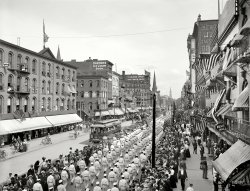
- Garden House: 1942
- ... fuzzy.
(The Gallery, Agriculture, Bicycles, Kids, Russell Lee) ... Posted by Dave - 04/23/2022 - 1:20pm -
![Garden House: 1942 February 1942. Woodville, Calif. "FSA farm workers' community. Son of agricultural worker at their garden house." Photo by Russell Lee for the Farm Security Administration. View full size.
Tyke TrikeSky King is another candidate for the tricycle - the back comes to a point like the one in the picture. I get the impression there were lots of competitors offering streamlined tricycles. It looks like the trike in the picture was rode hard and put away wet - paint and decorations are missing - but the boy seems satisfied with it.
I Like TrikeNever have I ever seen such a cool tricycle. And the tiny house looks very nice too.
Art moderneNever have I seen a streamlined tricycle that might have been designed by Raymond Loewy. If you had it today, it would be worth a bundle. I hope this kid appreciates it.
1935 Designer TrikeComplete with electric siren, even has wing-shaped pedals ... fabulous!
https://onlinebicyclemuseum.co.uk/1935-american-national-streamline-velo...
[That is fabulous, but not the same as the trike in the photo. Which has a streamlined "tail" for the body, in addition to the wheels. - Dave]
Very nice home designI like the simplicity, the large windows , and even a nice sunshade-trellis overhead with potential. Fast forward 50 years to the 5000 square-foot McMansions with only three living inside, with 32,000 sq ft of giant roofs, and rooms no one would ever use in a lifetime.
FarmvilleThe Woodville Farm Labor Center is still active today, with "one-hundred-seventy-eight 2, 3 and 4-bedroom units" available for agricultural workers. A New Deal site gave an address in Porterville, very near Woodville. The street view is of one house in the complex. There have been additions, but the windows have the right configuration. Unfortunately, the last time street view went through the area was 2007, so it's a little fuzzy.
(The Gallery, Agriculture, Bicycles, Kids, Russell Lee)](https://www.shorpy.com/files/images/SHORPY-8c23922a.thumbnail.jpg)
- Our Darling: 1914
- ... R.I.P.
Heartbreaking My ex and I often ride our bicycles past a cemetery out in the local Texas countryside. When we stopped to ... Posted by Dave - 11/03/2011 - 1:09pm -
![Our Darling: 1914 Washington, D.C. "J.J. Eaglen." A death notice in the May 18, 1914, Washington Post records the passing of one "John A. Eaglen, 3 years, 1000 8th st. nw." National Photo Company Collection glass negative. View full size.
Sad LossThere have been a few hard hitting photos posted but this one hit the hardest. Very sad.
In the weeds>> Then in 1943, for whatever reason, an application was filed to reinter the remains in Woodlawn Cemetery in Washington.
Woodlawn went into decline in the 1970s and was a ruin for many years - it's still in terrible shape (many stones down and broken, sections totally overgrown, etc.) but some efforts have been made to restore it in the last five years by a small nonprofit.
WonderingI wonder what carried off the poor child? The open casket is compelling, somehow, sharing the loss the parents must have suffered.
Melancholy PrinceAnother of those pictures that speak volumes.
Inconsolable GriefThere is nothing sadder or more heartbreaking than losing a blameless young child. His loved ones can never be the same people they were in the past as they are permanently, irreparably injured. This photo reminds me of a sweet male cousin of mine, an only child and grandchild who was fatally hit by a car at age 7. Anyone who has been touched by such a loss will never understand it or get over it. This viewing appears to be in the boy's own home, which was the custom when I was young. Even today, my heart aches for the people involved here. My mom's mom had eight children but it was before vaccinations and penicillin and only four lived to adulthood. Good night sweet prince. R.I.P.
HeartbreakingMy ex and I often ride our bicycles past a cemetery out in the local Texas countryside. When we stopped to have a look around we were shocked to see how many graves (circa late 1800s) were the final resting place of small children. I guess today we just take for granted that our children will have a long life. Rest in peace little J.J. Eaglen.
Viewings at homeThe father of a close friend died about 1961 when my friend was about 12 years old. There was an open-casket wake held in the parlor of the family's farmhouse in Galena, Illinois, the local custom of the time. My friend said that after that profoundly sad experience, he never passed through the room again without recalling that final view of his beloved father.
Escape HatchI am glad to see there is a drop-down egress provided: just in case.
The Way It WasIt was the common practice to "wake the deceased" at home in the parlor. The advent of funeral "homes" or "parlors" gave rise to the term "living room" in houses.
[The notion that the dead were laid out in parlors while the bereaved congregated in the "living room" is a sort of etymological urban legend debunked here and here and many other places. - Dave]
My son is 3This makes me cry.
John Alphonse Eaglen, son of J.J. Eaglen The Familysearch database returns records for the death certificate, permit for disinterment and reinterment of one John Alphonse (Alphonso) Eaglen. Like puzzle pieces, these records tell the story of a child born in 1911 that succumbed on May 16, 1914, at the age of 3 years, 5 months and 16 days. The cause of death was measles, complicated by a heart condition. He was buried in Sligo, Maryland. Then in 1943, for whatever reason, an application was filed to reinter the remains in Woodlawn Cemetery in Washington. One of the records describes a John Alphonse Eaglen that seemed to fit the scenario described here in every way, except for his being labeled as "black." Then I found the Census record for his father, J.J. Eaglen, which lists him as Mulatto.
Color lines, even in deathWoodlawn is an African-American cemetery established in 1892. For whatever reason, that could explain the boy's 1943 disinterment and re-interment.
It would be nice if a Shorpyite living in the DC area could locate his grave there, to see if he is buried among other Eaglens. Who knows, maybe some of his African-American relatives wanted his remains moved there, to be close to family.
Postmortem PhotographyIt seems that taking pictures of deceased children was a common practice in years past. Vintage photo collections show many such photos. It is perhaps less common a practice today now that most of us have and use cameras frequently and have taken pictures of the children before their now less frequent early death.
That tiny sprigIn little John's right hand, the slightly wilting flowers suggest he had been placed there probably that morning. His mother very likely brushed his hair one last time. Did she say, "My Johnny, my dear sweet Johnny"?
Although I hate to imagine it, his final days could not have been without suffering, made all the sadder by his total innocence. In some way the fact that we, strangers all, have gathered here to talk about him, with respect, is a memorial in some sense to his existence, a century later. Thank you, Dave, for making it possible.
Home FuneralMy mom died six weeks ago of complications from Alzheimer's disease after living with my husband and me for three years.
With the help of a home funeral guide, we washed Mom's body and prepared it for visitation. She died on a Wednesday, and visitation was at our home one Thursday and Friday. Mom was in her bed in her bedroom.
We used dry ice to keep the body cool.
On Saturday morning the funeral director came to take Mom's body away for cremation.
Now that we have "done" one home funeral, I wouldn't want it any other way.
All the yearsIt's especially sad to think that this child we see deceased here in 1914 could conceivably still be alive if he'd been fortunate enough to live into old age. All those years he did not get to see.
Childhood MortalityIt's sobering to remember that the average American lifespan at that time was under 50 years. That didn't mean that people didn't live to ripe old age, they did. It means that many many more infants and children died then. Measles was often fatal, so was whooping cough, diphtheria, and a myriad of other "childhood diseases."
Thank goodness for sanitation, clean water, and immunization.
On dying youngIn 1913 a typhoid fever epidemic in Central Pennsylvania took the lives of my mother's sister, Rose, at age 6, and their mother, age 29. Rose died 10 days after their mother. My Mom was four. Her father and stepbrother contracted the disease but survived. In any photo of my Mom before that, she appeared quite happy, but in every subsequent photo throughout her childhood, she looked very sad. Here she is at about 15, looking reflective but ready for adulthood.
The "good old days" weren't that greatWhenever we feel inclined to gripe about how hard life is, we should take a look at pictures like this. This is a poignant reminder of how good we have things today.
In 1914, there were no immunizations for many of the childhood diseases that we seldom think about now. Even when I was a child in the 1950s, the risk of death from measles, smallpox, polio and other diseases was still a big concern for parents. The flu outbreak of 1918 claimed millions of people around the world. Now, you can get a flu shot just by walking into your local Walgreen's.
Adequate sanitary systems were not in place in many communities, either, resulting in cholera and typhus outbreaks.
From a purely technological perspective, this photo reminds us of the wealth of technology we have at our fingertips. Back then, most people did not have cameras and could not afford to go to a portrait studio. This may be one of the few photos this family had of their child. Post-mortem photography was not uncommon in the Victorian Age through the first part of the 20th century, even to the point of posing parents and siblings with the deceased.
On a side note, judging by the unusual construction of the casket--it looks to be made of plaster or plaster-covered wood--I am wondering if this was a display casket provided by the funeral home just for wakes.
Thanks to all the contributors to Shorpy that help to provide interesting--and sometimes sobering--glimpses into the past.
HeartbreakingI can't imagine the grief that comes with losing a child; this one spent over 3 years on earth. He had already developed a personality, had likes and dislikes, and his parents no doubt had visions of what he would be when he was older. There is no sense to be found in such a loss.
His manner of death make me so grateful for public health and vaccines.
"Living room" vs. "parlour"Thanks, Dave, for debunking a common urban legend. So many American urban legends about language are based on the assumption that every phrase in English arose in the US.
Object LessonI hope that this ineffably sad photograph might serve as an object lesson for those fringe elements of our society who are opposed to vaccination. I have visited and photographed 19th Century children's graves in the West. One can notice evidence on the headstones of typhus epidemics and other preventable diseases, all within a short range of death dates.
"Sanitation, clean water, and immunization"Careful, Gary. Your triad of benefits that have ensured healthier living conditions could be viewed by many as "creeping nanny-state big government."
Right up there with child labor laws, meat quality inspections, and railroad safety.
Measles and vaccinationI nearly died as a child from either German or red measles (I had both in one year). I recently had occasion to face off against one of these "childhood diseases don't kill" people. They can. they can also cause deafness and blindness in the unborn and in infants. In the case of chickenpox, which despite this idiot's assertion to the contrary, does not render you immune to shingles but is the direct cause of it.
The anti-immunization zealots have had no personal experience with these disease and fail to realize that they were eradicated for a reason. Because epidemics killed thousands of children (and many adults) and were the cause of subsidiary medical conditions like deafness. It is because of them that we are seeing a resurgence of measles again.
[Part of this stems from the erroneous notion that vaccinations somehow lead to autism. - Dave]
A darling boyI can feel the parents' grief all these years later. God bless, darling John. Rest in peace, precious one.
The Times They Are a-Changin'The type of casket seen here is a full couch model, meaning the entire body is seen, as opposed to just the upper portion. It also has a drop front, which could be positioned to allow more of the body to be seen. The casket itself would be made of metal or wood, and is covered with a textured or flocked fabric. Some families would remove the plaque (in this case inscribed, “Our Darling”) as a keepsake from the funeral.
It is interesting to read children’s poetry from this era and note the number of references to death they include. At this time, as ironic as it may sound, death was a part of living. Today, for the most part, we have institutionalized death with people dying away from home, hooked up to numerous machines, and in a drug-induced state. Rare, indeed, are the last words of the dying.
In this age of online communication and impersonalization, it is intriguing that a resurgence in home funerals is occurring, as noted by contributor Crystal’s own personal experience. Before the advent of embalming – which was a by-product of the Civil War – it was normal for the family to be deeply involved in the preparation and burial of their loved ones. Today we look at it as a morbid, perhaps even backwards or bizarre thing to do, but who to better care for a family member than the ones who love them the most? And what better place to lie in state than the home they were so much a part of?
MeaslesOne of my aunts had German measles when pregnant in 1941. The doc told her the baby would be blind or deaf, and thank God he was born "only" with diminished hearing. He died in 2006. He was probably the best person I ever knew. RIP
(The Gallery, D.C., Kids, Natl Photo)](https://www.shorpy.com/files/images/SHORPY_31780u1.thumbnail.jpg)
- Main Street: 1905
- ... an Irish Pub called Siamsa.
Wheels That's what bicycles were commonly called in those days. We'd laugh in the mid-50's when ... She called windows "window lights", too.
(The Gallery, Bicycles, DPC, Small Towns) ... Posted by Dave - 08/21/2017 - 4:15pm -
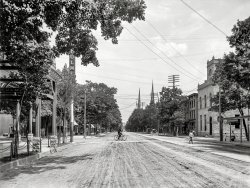
- Scouting Outing: 1937
- ... blessing to the Scouts of all nations.
(The Gallery, Bicycles, Boy Scouts, Cars, Trucks, Buses, D.C., Harris + Ewing) ... Posted by Dave - 08/13/2013 - 4:34pm -
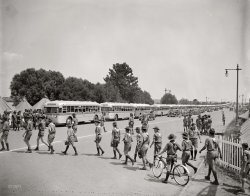
- Peoples Drug No. 2: 1921
- ... of those lion faces and stone "sashes":
(The Gallery, Bicycles, D.C., Natl Photo, PDS, Stores & Markets) ... Posted by Dave - 08/13/2013 - 4:07pm -
![Peoples Drug No. 2: 1921 Washington, D.C., circa 1921. "People's Drug Store, 7th and E Sts." National Photo Company Collection glass negative. View full size.
Ubiquitous AwningsAwning sales and service must have been big business back then.
All grown up nowStill there at 7th and E, but taller.
[Must be all those vitamins. - Dave]
View Larger Map
Shorpy Detective AgencyPre air conditioning, awnings were a key method of temperature control. They're also a good way of identifying south-facing sides of buildings for Shorpy Detective Agency operatives.
Like the Cheese Shop sketchThe display windows of People's Drug Store No. 2 are certainly uncontaminated by drugs.
Security ChainThis might be the first time I can remember seeing a bicycle chained to something in these early Shorpy photographs! Must be a bad neighborhood?
Dick Tracy villainsTwo Face and the One Legged Blur!
MoneyballDevoting a full window to cigars shows where the profits are.
Insurance manThe man in the third floor window of the Washington Insurance Agency appears as if he is looking right down at the person taking this photo. I like the looks of the old building so much better.
The Lions and Sashes Survived!Careful examination of the building (from another angle) shows the continued vitality of those lion faces and stone "sashes":
(The Gallery, Bicycles, D.C., Natl Photo, PDS, Stores & Markets)](https://www.shorpy.com/files/images/SHORPY_29966u.thumbnail.jpg)
- Howard's Chicken Shack: 1943
- ... on top of the sign? Had to be a chicken....right?
All bicycles had to have police issued license plate in the 40's?
A Small ... long-gone things, I wish I had it today!
(The Gallery, Bicycles, Eateries & Bars, Florida, Gordon Parks) ... Posted by Dave - 07/03/2016 - 12:14pm -
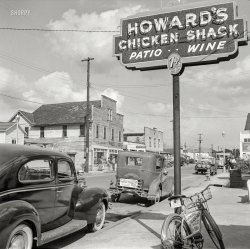
- Teeth Without Plates: 1905
- ... this... ...and a cigar store Indian!
(The Gallery, Bicycles, Detroit Photos, DPC, Railroads) ... Posted by Dave - 08/13/2013 - 3:35pm -
![Teeth Without Plates: 1905 Detroit, Michigan, circa 1905. "Cincinnati, Hamilton and Dayton Railroad office, Woodward & Jefferson Aves." A number of familiar Shorpy standbys here: The newsie, the "painless dental parlor," ectoplasmic pedestrians and a cameo by Goebel's beer. 8x10 inch glass negative, Detroit Publishing Co. View full size.
Which corner?Assuming the shot was taken in the afternoon, that would be the northeast corner of Woodward and Jefferson. The site is now occupied by the City-County building, subsequently renamed the Coleman A. Young building. The current structure was built in 1954.
[Our view is of the odd-numbered addresses on both streets -- the northwest corner. - Dave]
View Larger Map
Can someone enlighten me? What on earth is/was Vitalized Air? Some sort of anaesthetic, I'm guessing since it's listing with "laughing gas". Chlorform perhaps?
Also, I keep expecting the guy leaning against the post to whisper "Hey lady, wanna buy a watch?" and open his jacket to show them sewn into the lining...
Goebel'sThis Reich will last a thousand beers!
Little has changedBrakeless bikes, like the one in this great picture, are the 'modern' thing again now. They're called fixies these days.
Teeth without plates?OMIGOD!! Does that mean some Dr. Painless was trying to do dental implants in 1905? I hope the bar downstairs had plenty of Canadian Club under their sign for those poor suckers.
[I'd imagine that "teeth without plates" meant crowns and bridgework. - Dave]
Modern DentistryAgain, Shorpy jumps the gun, Teeth Without Plates, America's first implants.
A different edit of the shotMuch as I like the "King Leer" edit, I don't think it is a fair one. A different crop reveals something else entirely: All three people are looking at something down the street, although whatever it was, it was out of camera range (or ran into the store).
McGough's Chop HouseHalf a spring chicken and a Goebel's cool lager would taste pretty good right now.
Painless or notI don't find the picture of a naked molar comforting.
King LeerNote the guy checking out the chick, although given her clothes coverage, he must have a discerning eye.
Fountain pens at 20 pacesI'm curious about the oversize shotgun (punt gun?) seemingly suspended in midair near the Laughlin fountain pen sign.
[It's advertising the Cassius M. Havens sporting goods store below. Or possibly the Painless Dentist. - Dave]
Loooooooove this pictureTo me, this epitomizes every reason I visit Shorpy.... for the kind of minute details I see in these images. I loved everything in this one. I had grandparents born in the 1870s and can only wonder how they felt about the modern inventions just coming into their lives.
A new assignmentI want to try to determine exactly when bikes started appearing with fenders attached.
Goebel's -- the "Luxury Beer"Crazy wiresWhat's with the crazy wires that come out of the dentist office window- make a circuitous trip up to top floor then back down and into the sporting good store next door.
Oh?This reminds me of my first bike which was too big for me. I finally grew a bit, as I'm sure he did.
Love the expression on his face as he spots the photographer.
All that's missing isUneeda Biscuit!
Northwest CornerCirca 1920. (Wayne State University Virtual Library)
Hello Operator, give me HeavenThat call box -- a direct line to the man upstairs?
No Need for GasI'm laughing so hard reading all the signs that I might need some "Vitalized Air".
The entire process is spelled out right in the windows: Teeth without plates are offered in the room just to the right where there are "Gold & Porcelain Crowns". Moving over to the gas sign we find "Extractions Without Pain" in one room and at the next stop is the grand finale:
Of bikes and pensPer the amended "King Lear" I disagree that the kid is part of the scene and/or everyone is looking further to the right.
The bike isn't brakeless: it has a 'coaster brake' inside the rear hub. A slight back peddle pedal activates it. And down here in Florida, anyway, those 'basic' bikes are called Coasters or Cruisers.
The Laughlin Fountain Pens were manufactured in Detroit and seems to have had limited distribution around the country. For some reason, advertisements for them are being sold on eBay, but when I last check only two pens were for sale -- as quite expensive collector items. A brief biography of Mr Laughlin I found says:
To Coast or NotIt's a little hard to tell but I think the kid's bike didn't have coaster brakes. For starters, they were only invented in 1898, and this fellow doesn't look like he's riding the latest thing. Second, I would think that the hub would be quite a bit fatter. But third, the one characteristic sign of a coaster brake is that that there is a little arm that comes out from the hub and is anchored to the arm of the frame, and I see no sign of this in the photo.
All this......and a cigar store Indian!
(The Gallery, Bicycles, Detroit Photos, DPC, Railroads)](https://www.shorpy.com/files/images/4a20388a.thumbnail.jpg)
- Majestic: 1900
- ... Building and Campus Martius." The Motor City, back when bicycles and horses filled the streets. 8x10 glass negative. View full size. ... with things to do and people to see.
(The Gallery, Bicycles, Detroit Photos, DPC, Streetcars) ... Posted by Dave - 10/17/2020 - 10:41am -
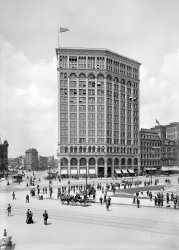
- Buchu Buttons: 1921
- ... Building' at 64 New York Ave NE.
(The Gallery, Bicycles, Cars, Trucks, Buses, D.C., Natl Photo, PDS) ... Posted by Dave - 08/13/2013 - 4:00pm -
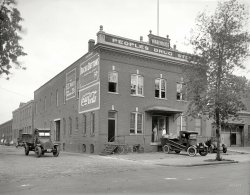
- Media Conglomerate: 1907
- ... New Zealand, 1907. "Wanganui Herald newspaper staff and bicycles, photographed by Frank J. Denton. Newsboys holding copies of ... men in camp? Or displaying appliances?
(The Gallery, Bicycles, Horses, New Zealand) ... Posted by Dave - 05/03/2014 - 3:03am -
